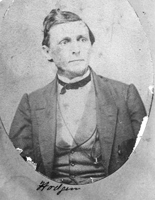Dr. John Thompson Hodgen, 1826–1882
|
Born on 19 January 1826 in Hodgenville, LaRue County, Kentucky, John Thompson Hodgen came from a pioneer family in that state. His father, Jacob Hodgen, was an elder in the Christian Church and married Frances Park Brown on 27 October 1818 in Elizabethtown, Hardin County, Kentucky. The family moved to Pittsfield, Pike County, Illinois, and John left there to attend Bethany College in West Virginia. After graduating medical school, he became assistant resident physician at St. Louis City Hospital for a year and worked as a “demonstrator of anatomy” at the University of Missouri, then located in St. Louis, from 1849 to 1853. On 28 March 1854, he married Elizabeth Delphine Mudd in Pike County, Illinois. Between 1855 and 1873, they had four sons, two of whom died in infancy. John served as chair of the anatomy and physiology departments at the University of Missouri through 1864. During the Civil War, he worked steadily as a surgeon, including surgeon-general for the state of Missouri for two years. After the Civil War wreaked havoc on his school, which was turned into a federal prison, he moved his medical/surgical practice to the St. Louis Medical College, where he assumed a leadership role again. (This school would become part of Washington University a decade after John’s death.) In 1875, he became dean of the faculty, a position he held until his death. He also taught clinical surgery at St. Louis City Hospital and served on the St. Louis Board of Health. He held numerous local and statewide positions in medical organizations. He was instrumental in improving sanitary conditions in hospitals in St. Louis and became so well-known that he was president of the American Medical Association the year before he died. His obituary compared him in importance with famed surgeon and innovator in antiseptic surgery, Dr. Joseph Lister! In 1880, John and Elizabeth lived on Washington Avenue in the City of St. Louis. They had sons Harry and John at home. Harry was in medical school and had his wife and baby daughter with him. |
 Dr. John Thompson Hodgen Photo in the collection of Ilene Kanfer Murray Used with permission |
|
During John Hodgen’s career, he invented a variety of surgical aids, including traction devices, splints, and a double-action syringe and stomach pump. His Hodgen splint for setting broken thigh bones is still in use. He was a pioneer in skin-grafting techniques. He wrote numerous medical articles and was known throughout the world when he died, much too young, of peritonitis brought on by an ulcerated gall bladder. In the years before he died, John Hodgen was the foremost medical person in St. Louis. He, Elizabeth, and son, Harry, who also became a physician, share a tall monument at Bellefontaine Cemetery in St. Louis. (Sources include articles written in several books and newspapers, the U.S. federal census, and a cemetery visit.) Written by Ilene Kanfer Murray © 2016, St. Louis Genealogical Society |
|
Return to St. Louis City/County Biographies.
Last Modified: 25-Oct-2018 21:41